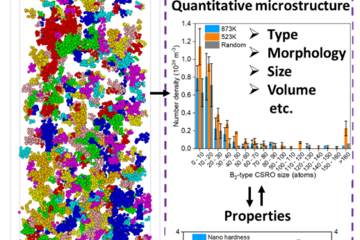All genres
1.
Journal Article
Precipitation and growth behavior of β0 phase in the α2/γ lamellar colonies of an intermetallic Ti–43.5Al–4Nb–1Mo–0.1B alloy. Journal of Alloys and Compounds 1020, 179381 (2025)
2.
Journal Article
A Modified Electrochemical Nanoindentation Setup for Probing Hydrogen-Material Interaction Demonstrated on a Nickel-Based Alloy. JOM-Journal of the Minerals Metals & Materials Society 72 (5), pp. 2020 - 2029 (2020)
3.
Journal Article
Microstructure evolution and mechanical properties of an intermetallic Ti–43.5Al–4Nb–1Mo–0.1B alloy after ageing below the eutectoid temperature. International Journal of Materials Research 102 (6), pp. 703 - 708 (2011)
4.
Journal Article
Nanometer-scaled lamellar microstructures in Ti–45Al–7.5Nb–(0; 0.5)C alloys and their influence on hardness. Intermetallics 16 (7), pp. 868 - 875 (2008)
5.
Journal Article
Creep behaviour and related high temperature microstructural stability of Ti-46Al-9Nb sheet material. Intermetallics 13 (5), pp. 515 - 524 (2005)
6.
Journal Article
Microstructure and mechanical properties of Si and YN doped powder metallurgical tantalum. Zeitschrift für Metallkunde/Materials Research and Advanced Techniques 95 (7), pp. 573 - 578 (2004)
7.
Journal Article
Mechanical Spectroscopy of a High Nb Containing γ-TiAl Based Alloy with Near Gamma and Fully Lamellar Microstructure. Philosophical Magazine Letters 84 (6), pp. 383 - 393 (2004)
8.
Journal Article
Characterization of biocompatible Ti(CNO) layers on polymeric substrates. Applied Surface Science 219 (3-4), pp. 329 - 337 (2003)
9.
Journal Article
Designed fully lamellar microstructures in a γ-TiAl based alloy: adjustment and microstructural changes upon long-term isothermal exposure at 700 and 800 degrees C. Materials Science and Engineering A-Structural Materials Properties Microstructure and Processing 329-331, pp. 124 - 129 (2002)
10.
Journal Article
On the role of twinning during room temperature deformation of γ-TiAl based alloys. Materials Science and Engineering A: Structural Materials Properties Microstructure and Processing 329-331, pp. 177 - 183 (2002)
11.
Journal Article
Microstructural stability and creep behavior of a lamellar γ-TiAl based alloy with extremely fine lamellar spacing. Intermetallics 10 (5), pp. 459 - 466 (2002)
12.
Journal Article
Strain rate dependence of the deformation mechanisms in a fully lamellar γ-TiAl-based alloy. Zeitschrift für Metallkunde/Materials Research and Advanced Techniques 93 (3), pp. 180 - 185 (2002)
13.
Journal Article
Creep behavior of γ-TiAl-based alloys with fully lamellar microstructure. Zeitschrift für Metallkunde/Materials Research and Advanced Techniques 92 (8), pp. 1000 - 1004 (2001)
14.
Journal Article
On the microstructural evolution and phase transformation in a high niobium containing γ-TiAl alloy. Zeitschrift für Metallkunde 91 (11), pp. 950 - 956 (2000)
15.
Journal Article
Computational modeling and experimental study of the deformation behaviour of γ-TiAl based alloys. Advanced Engineering Materials 2 (10), pp. 662 - 666 (2000)
16.
Journal Article
Onset of microstructural instability in a fully lamellar Ti-46.5 at.% Al-4 al.% (Cr,Nb,Ta,B) alloy during short-term creep. Zeitschrift für Metallkunde/Materials Research and Advanced Techniques 91 (9), pp. 755 - 760 (2000)
17.
Journal Article
On the origin of acoustic emission during room temperature compressive deformation of a γ-TiAl based alloy. Intermetallics 8 (7), pp. 823 - 830 (2000)
18.
Journal Article
Effect of heat treatments and hot-isostatic pressing on phase transformations and microstructure in a β/B2 containing γ-TiAl based alloy. Scripta Materialia 42 (11), pp. 1065 - 1070 (2000)
19.
Journal Article
Acoustic Emission during Room Temperature Deformation of a γ-TiAl Based Alloy. Zeitschrift für Metallkunde 90, pp. 581 - 587 (1999)
20.
Book Chapter
Microstructure and Properties of Engineering Materials. In: Neutrons and Synchrotron Radiation in Engineering Materials Science: From Fundamentals to Applications: Second Edition, pp. 3 - 20 (Eds. Schreyer, A.; Clemens, H.; Mayer, S.). wiley, Hoboken, NJ, USA (2017)











